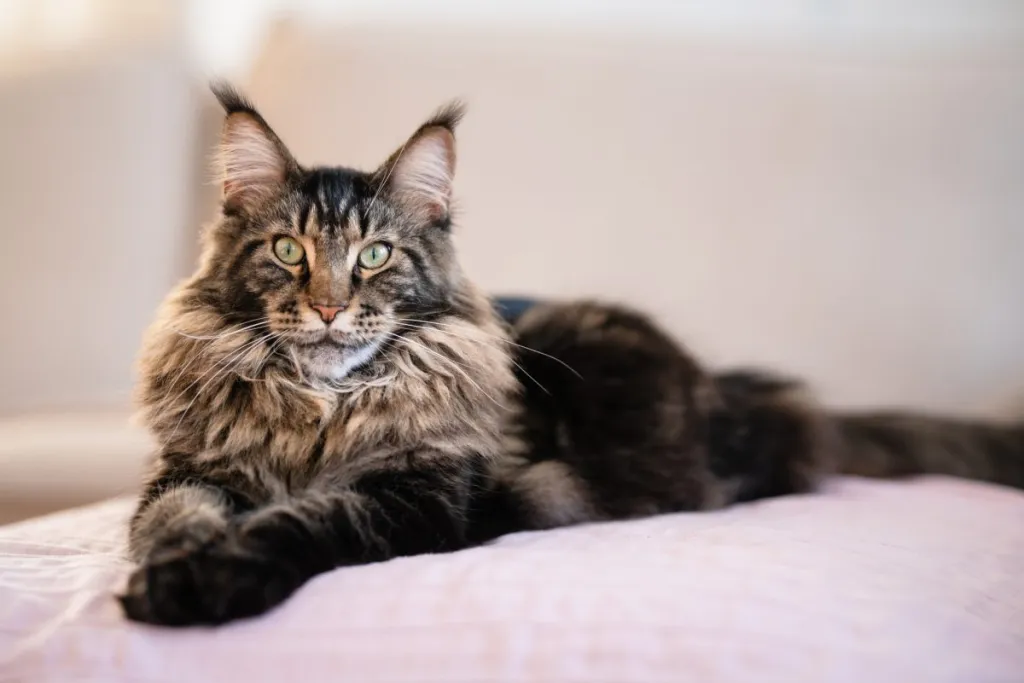The Maine Coon, one of the largest and oldest natural cat breeds, hails from Maine, where the breed was known as a popular mouser, farm cat, and ship’s cat as far back as the early 19th century. Known for their impressive size, tufted ears, bushy tails, and luxurious, semi-longhair coats, Maine Coon cats are easily recognizable. Also renowned for their friendly and sociable personalities, these cats are often called “gentle giants.” They are characterized by their intelligence, friendliness, playful temperament, and adaptability, making them well-suited for family life.
Despite their large size, Maine Coons are graceful and agile. Additionally, Maine Coons are often good with children and other pets, making them excellent companions for families. Their thick, water-resistant fur helps them adapt to various climates, and their tufted ears protect them from harsh weather conditions. With their affectionate nature and striking looks, Maine Coons have become a popular and beloved breed in many households around the world.
When considering a Maine Coon, it’s advisable to prioritize adopting from rescue organizations or shelters to provide a loving home to a cat in need. However, if you decide to purchase a Maine Coon kitten, it’s crucial to choose a reputable breeder. Conduct thorough research to ensure that the breeder follows ethical practices and prioritizes the well-being of their cats. Reputable Maine Coon breeders prioritize the health and temperament of their cats, conduct necessary health screenings, and provide a nurturing environment for the kitties. This active approach ensures you bring home a healthy and happy kitty while discouraging unethical breeding practices.
Quick Facts
- Origin: United States (Maine)
- Size: 8-18 pounds. Maine Coons are one of the largest domesticated cat breeds. Adult males typically weigh between 13 to 18 pounds (5.9 to 8.2 kilograms) or more, while adult females are slightly smaller, usually ranging from 8 to 12 pounds (3.6 to 5.4 kilograms). Some exceptional Maine Coons can even exceed these weight ranges. They have a long, muscular body with a solid bone structure.
- Breed Group: Natural
- Lifespan: 12 to 15 years
- Coat: Long, thick, and water-repellent; comes in various colors and patterns.
- Temperament: Gentle, friendly, and sociable; known for their intelligence and playfulness
- Exercise Needs: Moderate; they enjoy interactive play and may need some space to roam
- Training: Easily trainable; they are intelligent and can learn tricks and commands
- Grooming: Regular grooming is necessary due to their long fur; brushing a few times a week helps prevent matting
- Health: Generally healthy breed, but can be prone to certain genetic conditions like hip dysplasia and heart disease; regular vet check-ups are important.
- Fun fact: a Maine Coon holds the record for being the world’s longest house cat, measuring over four feet in length.
- They are the second-largest cat breed in the world, after the Norwegian Forest Cat.
- A Maine Coon named Winston Churchill is the subject of the 2019 film “Pet Sematary,” based on Stephen King’s novel of the same name.
- The average price range of purchasing from a reputable purebred Maine Coon breeder could be anywhere between $1,000 to $2,000. Despite their popularity, many still end up in shelters. Always prioritize adoption!
Maine Coon Pictures
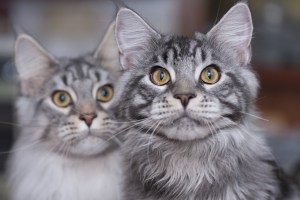
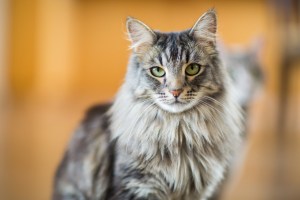
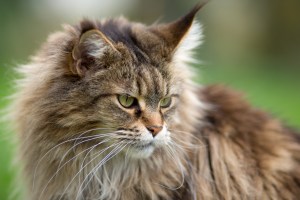
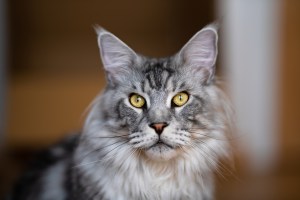
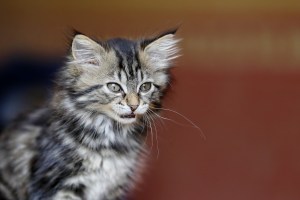
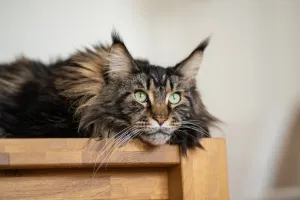
-
Affectionate with Family
Some cat breeds are typically independent and aloof, even if they’ve been raised by the same person since kittenhood; others bond closely to one person and are indifferent to everyone else; and some shower the whole family with affection. Breed isn’t the only factor that goes into affection levels; cats who were raised inside a home with people around feel more comfortable with humans and bond more easily.

See Cats Less Affectionate with Family -
Amount of Shedding
If you’re going to share your home with a cat, you’ll need to deal with some level of cat hair on your clothes and in your house. However, shedding does vary among the breeds. If you’re a neatnik, you’ll need to either pick a low-shedding breed or relax your standards. This furniture cover can make it easier to clean up cat hair and keep it off your sofa!
-
General Health
Due to poor breeding practices, some breeds are prone to certain genetic health problems. This doesn’t mean that every cat of that breed will develop those diseases; it just means that they’re at an increased risk. If you’re looking only for purebred cats or kittens, it’s a good idea to find out which genetic illnesses are common to the breed you’re interested in.
-
Potential for Playfulness
Some cats are perpetual kittens—full of energy and mischief—while others are more serious and sedate. Although a playful kitten sounds endearing, consider how many games of chase the mouse-toy you want to play each day, and whether you have kids or other animals who can stand in as playmates. A classic wand cat toy like this one is perfect for playful felines!
-
Tendency to Vocalize
Some breeds sound off more often than others with meows, yowls, and chattering. When choosing a breed, think about how the cat vocalizes and how often. If constant “conversation” drives you crazy, consider a kitty less likely to chat.
-
Kid-Friendly
Being tolerant of children, sturdy enough to handle the heavy-handed pets and hugs they can dish out, and having a nonchalant attitude toward running, screaming youngsters are all traits that make a kid-friendly cat. Our ratings are generalizations, and they’re not a guarantee of how any breed or individual cat will behave; cats from any breed can be good with children based on their past experiences and personality.
-
Friendly Toward Strangers
Stranger-friendly cats will greet guests with a curious glance or a playful approach; others are shy or indifferent, perhaps even hiding under furniture or skedaddling to another room. However, no matter what the breed, a cat who was exposed to lots of different types, ages, sizes, and shapes of people as a kitten will respond better to strangers as an adult.
-
Easy to Groom
Some breeds require very little in the way of grooming; others require regular brushing to stay clean and healthy. Consider whether you have the time and patience for a cat who needs daily brushing. You should definitely pick up this awesome de-shedding tool for cats of any hair length!
-
Intelligence
Some cat breeds are reputed to be smarter than others. But all cats, if deprived the mental stimulation they need, will make their own busy work. Interactive cat toys are a good way to give a cat a brain workout and keep them out of mischief. This scratcher cat toy can keep your smart kitty busy even when you’re not home!
-
Pet Friendly
Friendliness toward other household animals and friendliness toward humans are two completely different things. Some cats are more likely than others to be accepting of other pets in the home.
Maine Coon History
As the name implies, the Maine Coon originated in Maine, where the breed was known as a farm cat, ship cat, and mouse, with historical records dating back to the 1850s. They’re a natural breed, and little is known about their origins. Some say the Vikings brought them to North America centuries before Columbus sailed the ocean blue.
Others say they’re the descendants of longhaired cats belonging to Marie Antoinette, sent to America in advance by the doomed queen, who had hoped to escape there. Sea captains may have brought back longhaired cats that mated with local shorthaired cats.
One thing is for sure— the Maine Coon is not the result of a mating between a cat and a raccoon, even if their brown tabby coat and furry ringed tail suggest that biological impossibility. The resemblance is, however, how the cats got the “Coon” part of their name. Maine Coons who didn’t have the brown tabby coat were called Maine Shags. The first published reference to a Maine Coon comes from 1861 and was about a black-and-white cat named Captain Jenks of the Horse Marines.
A female Maine Coon was named Best Cat in 1895 at a cat show held in Madison Square Garden. In Boston and New York, the home-grown felines were popular exhibits at cat shows, and when the Cat Fanciers Association was formed in 1908, the fifth cat registered was a Maine Coon named Molly Bond.
But the invasion of glamorous Persian and exotic Siamese cats from England around the turn of the century spelled the end of the Maine Coon’s popularity for about five decades. Things took a turn for the better in the 1960s, and the Maine Coon Breeders and Fanciers Association was formed in 1968. Today, these big, beautiful cats are among the world’s most popular breeds. But what counts, of course, is that they are the official state cat of Maine.
Maine Coon Size
This is a large cat. Most Maine Coons weigh 9 to 18 pounds–males are larger–and some tip the scales at 20 or more pounds. They don’t reach their full size until they are three to five years old.
Maine Coon Personality
The good-natured and affable Maine Coon adapts well to many lifestyles and personalities. They like being with people and have the habit of following them around, but they aren’t needy. They’re happy to receive attention when you direct it their way, but if you’re busy, they’re satisfied to just supervise your doings. Close a door on them and they will wait patiently for you to realize the error of your ways and let them in. They’re not typically a lap cat, but they do like to be near you. They also retain their skill as a mouser. No rodents will be safe in a home where a Maine Coon resides. Even if you don’t have any mice for them to chase, they’ll keep their skills sharp by chasing toys and grabbing them with their big paws. A Maine Coon also enjoys playing fetch and will retrieve small balls, toys, or wadded-up pieces of paper. They can climb as well as any cat but usually prefer to stay on ground level. That’s where their work is, after all. They’re also very smart and will happily learn tricks or play with puzzle toys that challenge their brain. Maine Coons usually enjoy a kittenish love of play well into adulthood. Males, especially, are prone to silly behavior. Females are more dignified, but they aren’t above a good game of chase. Not especially vocal, they make any requests in a soft chirp or trill.
Maine Coon Health
Both pedigreed cats and mixed-breed cats have varying incidences of health problems that may be genetic in nature. Problems that may affect the Maine Coon include the following:
- Hip Dysplasia: Hip dysplasia is a relatively uncommon but serious orthopedic condition that primarily affects dogs. While it is rare in cats, it is not impossible for them to develop hip dysplasia.
- Hypertrophic cardiomyopathy: HCM is a common heart condition in cats, including Maine Coons. It involves the thickening of the heart muscles, which can affect the heart’s ability to function properly. Regular veterinary check-ups and echocardiograms can help detect and manage HCM.
- Polycystic Kidney Disease: Polycystic Kidney Disease (PKD) is an inherited genetic disorder that affects cats, among other animals. This condition leads to the development of fluid-filled cysts in the kidneys, which can interfere with their normal function and, over time, lead to kidney failure.
- Spinal Muscular Atrophy: Spinal Muscular Atrophy (SMA) in cats is a genetic disorder that affects the spinal cord and the motor neurons responsible for controlling muscle movement. It’s a relatively rare condition but can cause significant mobility issues in affected Maine Coons.
Maine Coon Care
Despite the length of the Maine Coon’s coat, it has a silky texture that doesn’t mat easily—if you groom it regularly. It is easily cared for with twice weekly combing to remove dead hair and distribute skin oils. Useful grooming tools include a stainless steel comb for removing tangles and what’s called a “grooming rake” to pull out dead undercoat, which is what causes tangles when it’s not removed. Use it gently, especially in the stomach area and on the tail.
Maine Coons are patient, but they don’t like having their hair pulled any more than you do. Check the tail for bits of poop stuck to the fur and clean it off with a baby wipe. Bathe a Maine Coon as needed, which can range from every few weeks to every few months.
If their coat feels greasy or their fur looks stringy, they need a bath. Brush the teeth to prevent periodontal disease. Daily dental hygiene is best, but weekly brushing is better than nothing. Trim the nails every couple of weeks.
Wipe the corners of the eyes with a soft, damp cloth to remove any discharge. Use a separate area of the cloth for each eye so you don’t run the risk of spreading any infection. Check the ears weekly. If they look dirty, wipe them out with a cotton ball or soft damp cloth moistened with a 50-50 mixture of cider vinegar and warm water.
Avoid using cotton swabs, which can damage the interior of the ear. Keep the Maine Coon’s litter box spotlessly clean. Cats are very particular about bathroom hygiene, and a clean litter box will help to keep the coat clean as well.
It’s a good idea to keep a Maine Coon as an indoor-only cat to protect them from diseases spread by other cats, attacks by dogs or coyotes, and the other dangers that face cats who go outdoors, such as being hit by a car. Maine Coons who go outdoors also run the risk of being stolen by someone who would like to have such a beautiful cat without paying for it.
Maine Coon Coat Color And Grooming
A Maine Coon is a big, rugged cat with a smooth, shaggy coat who looks as if they could put in a full day mousing on a farm in all weather conditions. Indeed, they were built for just such work in the harsh Maine climate, and their breed standard reflects their heritage, calling for a medium-size to large cat with a well-proportioned body that is muscular and broad-chested. A
Maine Coon has substantial, medium-length legs and large, round paws, well tufted with fur, to serve as “snowshoes” during winter. A heavy coat is shorter on the shoulders, longer on the stomach and britches (long fur on the upper hind legs), with a ruff in front and a long, furry tail waving a greeting.
A medium-width head is slightly longer than it is wide and has a squarish muzzle. Large, well-tufted ears are wide at the base, tapering to a point, and large, expressive eyes are green, gold, greenish-gold or copper. White or bi-colored Maine Coons may have blue or odd eyes. The brown tabby pattern is so common in this breed that many people don’t know Maine Coons can come in any other colors or patterns.
They might be surprised to learn that Maine Coons are found in solid colors that include black, red or white, all tabby colors and patterns, bi-color such as blue and white or red and white, and patterns such as tortoiseshell and calico.
Children And Other Pets
The friendly, laid back Maine Coon is a perfect choice for families with children and cat-friendly dogs. They love the attention they receive from children who treat them politely and with respect, and they don’t mind playing dress-up or going for a ride in a baby buggy.
They’re happy to live with cat-friendly dogs, too, thanks to their amiable disposition. Introduce pets slowly and in controlled circumstances to ensure that they learn to get along together.
Maine Coon Rescue Groups
There are many rescue organizations for cats, and some are even breed-specific. Try searching for a nonprofit Maine Coon rescue near you if you’re interested, or try the links below.
